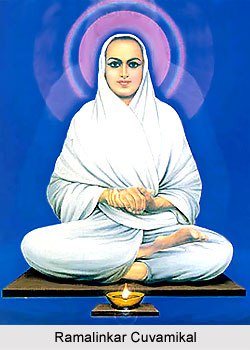 Ramalinkar Cuvamikal, also known as Ramalihkar Cuvamikal or Ramalinkar Adigal, was one of the greatest Tamil poets of the 19th century and was considered amongst the most renowned Tamil saints. He belonged to a line of saints who were identified as Gnana Siddhars. Ramalinkar Cuvamikal was also known as Arutprakasa Vallalar Chidambaram Ramalinkar m and was popular through out the country, as well as the globe, as Vallalar. The Suddha Sanmarga Sangam was propagated and promulgated by Ramalinkar Cuvamikal mainly in practice, but also in theory, through his own way of living that inspired his numerous followers. Through the concept of Suddha Sanmarga Sangam, the poet saint attempted to eradicate the threat of caste. The Suddha Sanmarga states that the primary facets of life should be love related with charity and divine practice which will lead to attainment of chaste knowledge.
Ramalinkar Cuvamikal, also known as Ramalihkar Cuvamikal or Ramalinkar Adigal, was one of the greatest Tamil poets of the 19th century and was considered amongst the most renowned Tamil saints. He belonged to a line of saints who were identified as Gnana Siddhars. Ramalinkar Cuvamikal was also known as Arutprakasa Vallalar Chidambaram Ramalinkar m and was popular through out the country, as well as the globe, as Vallalar. The Suddha Sanmarga Sangam was propagated and promulgated by Ramalinkar Cuvamikal mainly in practice, but also in theory, through his own way of living that inspired his numerous followers. Through the concept of Suddha Sanmarga Sangam, the poet saint attempted to eradicate the threat of caste. The Suddha Sanmarga states that the primary facets of life should be love related with charity and divine practice which will lead to attainment of chaste knowledge.
Early Life of Ramalinkar Cuvamikal
Ramalinkar Cuvamikal was born on 5th October, 1823 and was the youngest child of Ramiah Pillai and Chinnamaiar (his sixth wife), who resided in a village towards the north west of Chidambaram, in Marudur in South Arcot district. The poet saint had 4 other siblings, two elder brothers Sabhapati and Parasuraman, and two elder sisters named Sundarammal and Unnamali. In the year 1824, after his father Ramiah Pillai died, Ramalinkar Cuvamikal`s mother Chinnamaiar shifted to the residence of Sabhapati, her eldest son and his wife Parvathi, at Madras (Chennai).
When Ramalinkar Cuvamikal was merely 5 years old, Sabhapati attempted to formally educate his brother Ramalinkar, but the young poet portrayed unwillingness towards formal education. Instead he preferred trips to the local Kandasamy temple.
Ramalinkar Cuvamikal as a Saint
Ramalinkar Cuvamikal is considered as one of the most prominent saints of India due to his numerous activities. He openly declared the adverse impact of caste system on society and voiced against it. He established the Samarasa Suddha Sanmarga Satya Sangam, which means Society for pure truth in universal self-hood, in the year in 1865, in an effort to rectify the situation. Ramalinkar Cuvamikal or Arutprakasa Vallalar Chidambaram Ramalinkar m also established a free eating house known as Sathya Dharma Salai in 1867, in the region of Vadalur, as a practical approach to religion. The Sathya Dharma Salai provided food to every one without any distinctions. The poet saint of the nineteenth century also detested non-vegetarianism.
In the year 1872, Ramalinkar Cuvamikal set up the Sathya Gnana Sabha (Hall of True Knowledge) at Vadalur. He taught several ethical and moral codes to his followers and one of his primary teachings was service to mankind is path of moksha (salvation). He stated that the Lord is Arul Perum Jothi who is the embodiment of mercy and knowledge. He propagated a casteless society and was opposed to rituals and superstitions. Ramalinkar Cuvamikal prevented killing animals for the sake of food and announced that feeding the deprived was the ultimate form of worship. He also condemned inequality based on birth.
Literary Works of Ramalinkar Cuvamikal
Ramalinkar Cuvamikal composed over six thousand verses and they were compiled under the title Arutpa. The work is classified into 6 sections known as Tirumuraikal. He also wrote two prose works, namely the Civakarunya Olukkam and the Manumuraikanta Vacakam. His style of composing prose is rather burdensome and rather difficult to grasp. But his poems were composed in a simple and lucid style with adequate mellifluousness and clarity. The verses are easy to read and captivate the minds of the readers as the devotional hymns are charged with emotions. Some of the verses that were composed in the akam tradition are still extant in Inkitamalai and other chapters of the Arutpa. These poems are popular for their literary elegance.
Besides writing thousand of poems in the viruttam metre, Ramalinkar Cuvamikal composed numerous verses in the form of folk songs, such as the Kirttanai, Kummi, Kanni, and Cintu. The poet saint also wrote devotional hymns like Sri Virarakavap Perumal Porrit Tiruppahcakam, Sri Ramanamat Tiruppatikam and Ilakkumi Tottiram. Most of poems like Vennilappattu and Anantakkalippu were based on folk songs. He also composed the traditional type of ulas namely Tiruvulapperu, Tirukkolac Cirappu, Tiruvulat Tiram and Tiruvula Viyappu. The poems are extremely imaginative and creative which focuses on the divine love of the heroine of the tale, who falls in love with Lord Shiva while he was on a procession.
Ramalinkar Cuvamikal, also known as Ramalinkar Adigal, composed verses in a simple and elegant manner that is rich with subtle philosophical experiences. His other works include Katcikkanni, Manumurai Kanda Vaasagam and Jeeva Karunya Ozhukkam.



















